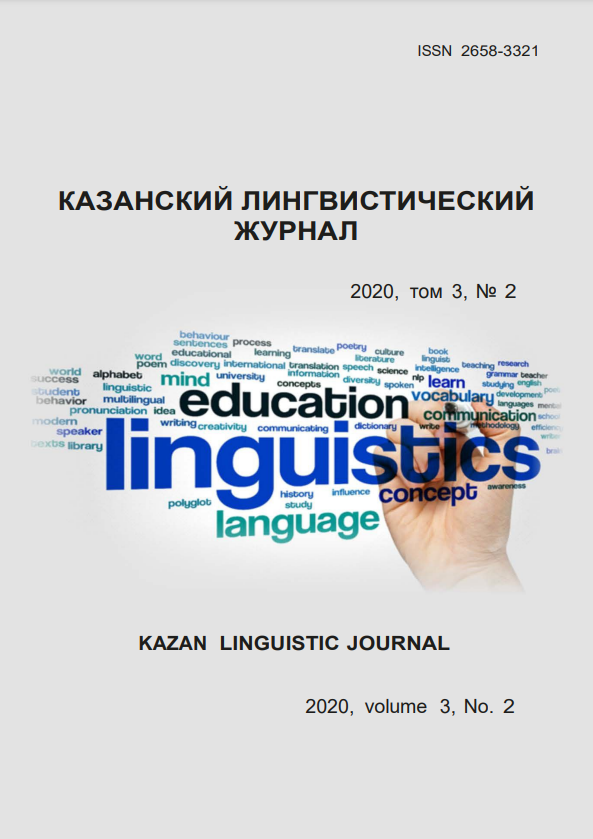Teaching Russian as a foreign language using the input language material (comprehensible input, ci) in speech communication
Keywords:
communicative method, the Russian language, monitor model, input material, oral activityAbstract
This article is devoted to the methods of teaching Russian as a foreign language. The author emphasized the communicative method, which is currently used in the teaching of the second languages as foreign languages. Krashen’s Monitor Model based on the acquisition-learning dichotomy was reviewed as a model for learning a second foreign language. This theory namely the hypothesis of input material (comprehensible input, i + 1) was selected and put into practice for the development of students' oral activities. According to the author, it is necessary that the exercise is more complicated and contains new didactic and significant materials that can interest and motivate the students in order to improve their speech activity. Furthermore, correctly formulated teacher’s question develops the student’s dialogical speech and multidirectional communication of speaking. As a result of the study, the author concludes that the i + 1 exercises are effective and adapted to the needs of the students. In this case, the development of oral skills will occur without a language barrier and in a meaningful way that is adapted to real life.
References
Литература
Басалаева Н.В., Захарова Т.В. Ключевые компетенции как интегральный результат современного образования // Сибирский педагогический журнал. Лесобирск, 2012. С 184.
БочарниковаМ.А. Понятие «коммуникативная компетенция» и его становление в научной среде // Молодой ученый. 2009. С. 130-132.
ГатауллинаЛ.К. О некоторых методах преподавания на занятиях по РКИ // Вестник Казанского технологического университета. Казань, 2012. С 277.
Дмитриева Д.Д. Виды упражнений для обучения устной речи на занятиях по русскому языку как иностранному (на начальном этапе обучения) // Карельский научный журнал. Курск, 2018. С 29-31.
КиндряН.А. Место и роль коммуникативно-речевой ситуации при обученииговорению // Педагогический журнал. 2018. Т. 8. № 1А. С. 123-131.
Кузнецов Д. Нейрофизиологи подтвердили теорию «врожденной грамматики» Хомского // [Электронный ресурс] // Интернет-журнал «N+1» 2015. // Режим доступа: https://nplus1.ru/news/2015/12/08/Colorless-green-ideas- sleep-furiously
Лебединский С.И., Гербик Л.Ф. Методика преподавания русского языка как иностранного: учеб. пособие. Мн.: Белорусский государственный экономический университет, 2011. 6 с.
Синицына Ю.Н., КурдубанО.Н., Корниенко В.В. Метод молчания (silentway) как способ формирования навыков самостоятельной работы при изучении иностранного языка у студентов неязыковых специальностей и направлений // Вестник Ленинградского государственного университета им. А.С. Пушкина. Санкт-Петербург, 2019. С.177.
Тайтус Ю. Цели и мотивация студентов с русским языковым наследием при изучении русского языка за рубежом. Казанский лингвистический журнал. 2019; 2 (2): 144-160.
Хуторской А.В. Ключевые компетенции и образовательные стандарты
// [Электронный ресурс] // Интернет-журнал «Эйдос». 2002. 23 апреля. // Режим доступа: http://www.eidos.ru/journal/2002/0423.htm
References
Basalaeva, N.V., Zaharova, T.V. (2012). Klyuchevye kompetencii kak integral'nyj rezul'tat sovremennogo obrazovaniya [Key competencies as an integral result of modern education] // Sibirskij pedagogicheskij zhurnal. Lesobirsk. S. 184. (In Russian)
Bocharnikova, M. A. (2009). Ponyatie kommunikativnaya kompetenciyai ego stanovlenie v nauchnoj srede [The concept of communicative competence and its formation in the scientific community] // Molodojuchenyj. S. 130-132. (In Russian)
Gataullina, L.K. (2012). O nekotoryh metodah prepodavaniya na zanyatiyah po RKI [About some teaching methods in RAF classes] // Vestnik Kazanskogo tekhnologicheskogo universiteta. Kazan'. S. 277. (In Russian)
Dmitrieva, D.D. (2018). Vidy uprazhnenij dlya obucheniya ustnoj rechi na zanyatiyah po russkomu yazyku kak inostrannomu (na nachal'nom etape obucheniya) [Types of exercises for teaching oral speech in the classes of Russian as a foreign language (at the initial stage of training)] // Karel'skij nauchnyj zhurnal. Kursk. S. 29-
(In Russian)
Kindrya, N.A. (2018). Mesto i rol' kommunikativno-rechevoj situacii pri obuchenii govoreniyu [The place and role of the communicative-speech situation in teaching speaking] // Pedagogicheskij zhurnal. T. 8. № 1A. S. 123-131. (In Russian)
Kuznecov, D. (2015). Nejrofiziologipodtverdiliteoriyu
«vrozhdennojgrammatiki» Homskogo [Neurophysiologist confirms Chomsky’s theory of “innate grammar”] // [Elektronnyj resurs] // Internet-zhurnal «N+1» // URL: https://nplus1.ru/news/2015/12/08/Colorless-green-ideas-sleep-furiously. (In Russian)
Lebedinskij, S.I., Gerbik, L.F. (2011). Metodika prepodavaniya russkogo yazyka kak inostrannogo [Methods of teaching Russian as a foreign language]: ucheb. posobie. Mn.: Belorusskij gosudarstvennyj ekonomicheskij universitet. S. 6. (In Russian)
Sinicyna, YU.N., Kurduban, O.N., Kornienko V.V. (2019). Metod molchaniya (silent way) kak sposob formirovaniya navykov samostoyatel'noj raboty pri izuchenii inostrannogo yazyka u studentov neyazykovyh special'nostej i napravlenij [The method of silence (silent method) as a way of forming skills of independent work when studying a foreign language in students of non-language special and directing] // Vestnik Leningradskogo gosudarstvennogo universiteta im.
A.S. Pushkina. Sankt-Peterburg. S.177.(In Russian)
Titus Ju. Russian heritage learners’ goals and motivation. Kazan Linguistic Journal. 2019. 2 (2): 144–160. (In Russian)
Hutorskoj A.V. (2002). Klyuchevye kompetencii i obrazovatel'nye standarty [Key competencies and educational standards] // [Elektronnyjresurs] // Internet-zhurnal «Ejdos» // URL: http://www.eidos.ru/journal/2002/0423.htm (In Russian)






